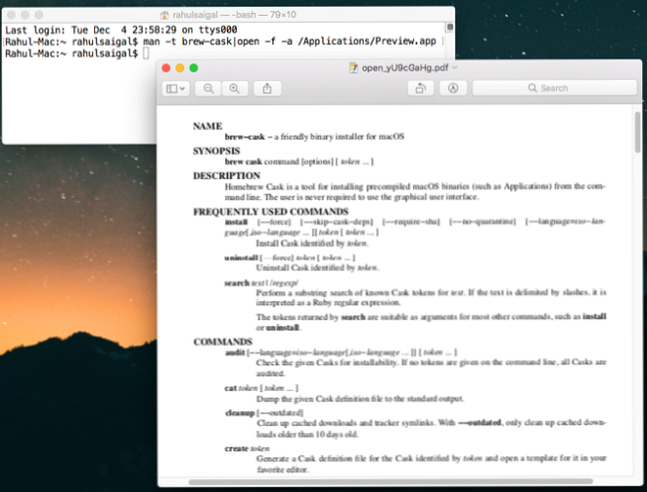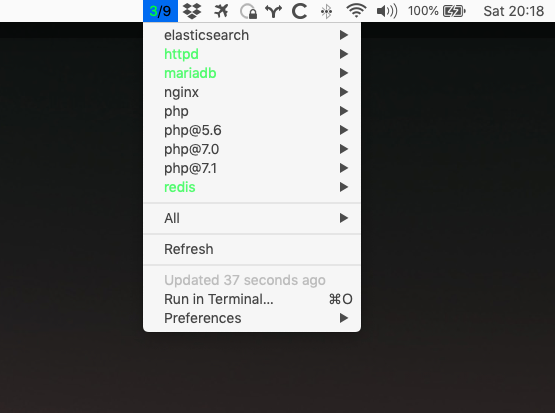The Homebrew package manager may be used on Linux and Windows Subsystem for Linux (WSL). Homebrew was formerly referred to as Linuxbrew when running on Linux or WSL. It can be installed in your home directory, in which case it does not use sudo. Homebrew does not use any libraries provided by your host system, except glibc and gcc if they are new enough. Homebrew can install its own current versions of glibc and gcc for older distributions of Linux.
Type brew search for a list. Or visit formulae.brew.sh to browse packages online. Or use brew search -desc to browse packages from the command line. More Documentation. Brew help, man brew or check our documentation. First, please run brew update and brew doctor. Second, read the Troubleshooting Checklist. How can you get the tree-like view of commits in terminal? Git log -graph -oneline -all is a good start. You may get some strange letters. They are ASCII codes for colors and structure. To solve this problem add the following to your.bashrc: export LESS='-R' such that you do not need use Tig's ASCII filter.
Features, installation instructions and requirements are described below. Terminology (e.g. the difference between a Cellar, Tap, Cask and so forth) is explained in the documentation.
Features
- Can install software to your home directory and so does not require sudo
- Install software not packaged by your host distribution
- Install up-to-date versions of software when your host distribution is old
- Use the same package manager to manage your macOS, Linux, and Windows systems
Install
Instructions for a supported install of Homebrew on Linux are on the homepage.
The installation script installs Homebrew to /home/linuxbrew/.linuxbrew using sudo if possible and in your home directory at ~/.linuxbrew otherwise. Homebrew does not use sudo after installation. Using /home/linuxbrew/.linuxbrew allows the use of more binary packages (bottles) than installing in your personal home directory.
The prefix /home/linuxbrew/.linuxbrew was chosen so that users without admin access can ask an admin to create a linuxbrew role account and still benefit from precompiled binaries. If you do not yourself have admin privileges, consider asking your admin staff to create a linuxbrew role account for you with home directory /home/linuxbrew.
Follow the Next steps instructions to add Homebrew to your PATH and to your bash shell profile script, either ~/.profile on Debian/Ubuntu or ~/.bash_profile on CentOS/Fedora/Red Hat.

You’re done! Try installing a package:

If you’re using an older distribution of Linux, installing your first package will also install a recent version of glibc and gcc. Use brew doctor to troubleshoot common issues.
Requirements
- GCC 4.7.0 or newer
- Linux 2.6.32 or newer
- Glibc 2.13 or newer
- 64-bit x86_64 CPU
Paste at a terminal prompt:
Debian or Ubuntu
Fedora, CentOS, or Red Hat
ARM
Homebrew can run on 32-bit ARM (Raspberry Pi and others) and 64-bit ARM (AArch64), but no binary packages (bottles) are available. Support for ARM is on a best-effort basis. Pull requests are welcome to improve the experience on ARM platforms.
You may need to install your own Ruby using your system package manager, a PPA, or rbenv/ruby-build as we no longer distribute a Homebrew Portable Ruby for ARM.
32-bit x86
Homebrew does not currently support 32-bit x86 platforms. It would be possible for Homebrew to work on 32-bit x86 platforms with some effort. An interested and dedicated person could maintain a fork of Homebrew to develop support for 32-bit x86.
Alternative Installation

Extract or git clone Homebrew wherever you want. Use /home/linuxbrew/.linuxbrew if possible (to enable the use of binary packages).
Homebrew on Linux Community
Installation
Homebrew is package manager for Macs which makes installing lots of different software like Git, Ruby, and Node simpler. Homebrew lets you avoid possible security problems associated with using the sudo command to install software like Node.
Prerequisites
- You should have some familiarity with the Mac Terminal application since you’ll need to use it to install Homebrew. The Terminal application is located in the Utilities folder in the Applications folder.
- Dependencies. You need to install one other piece of software before you can install Homebew:
- Xcode. Install Apple’s Xcode development software: Xcode in the Apple App Store.
Installation Overview
Installing Homebrew is straightforward as long as you understand the Mac Terminal. The Homebrew installation process guides through each step.
:max_bytes(150000):strip_icc()/001_how-to-install-homebrew-on-mac-4780201-8d9a84f726c14ebb92565f6de7f7b8f6.jpg)
Terminal Brewhouse
Installation Steps
- Open the Terminal app.
- Type
ruby -e '$(curl -fsSL https://raw.githubusercontent.com/Homebrew/install/master/install)'You’ll see messages in the Terminal explaining what you need to do to complete the installation process. You can learn more about Homebrew at the Homebrew website.
How to Update Homebrew
Brew Terminal Emacs
New versions of Homebrew come out frequently, so make sure you update it before updating any of the other software components that you’ve installed using Homebrew.* In Terminal type brew update

Terminal Brew Not Found
How to Uninstall Homebrew
Brew Terminal-notifier
- Open the Terminal app
- Type
ruby -e '$(curl -fsSL https://raw.githubusercontent.com/Homebrew/install/master/uninstall)'This downloads and runs the uninstaller script. Follow the instructions and Homebrew will be removed from your computer.
